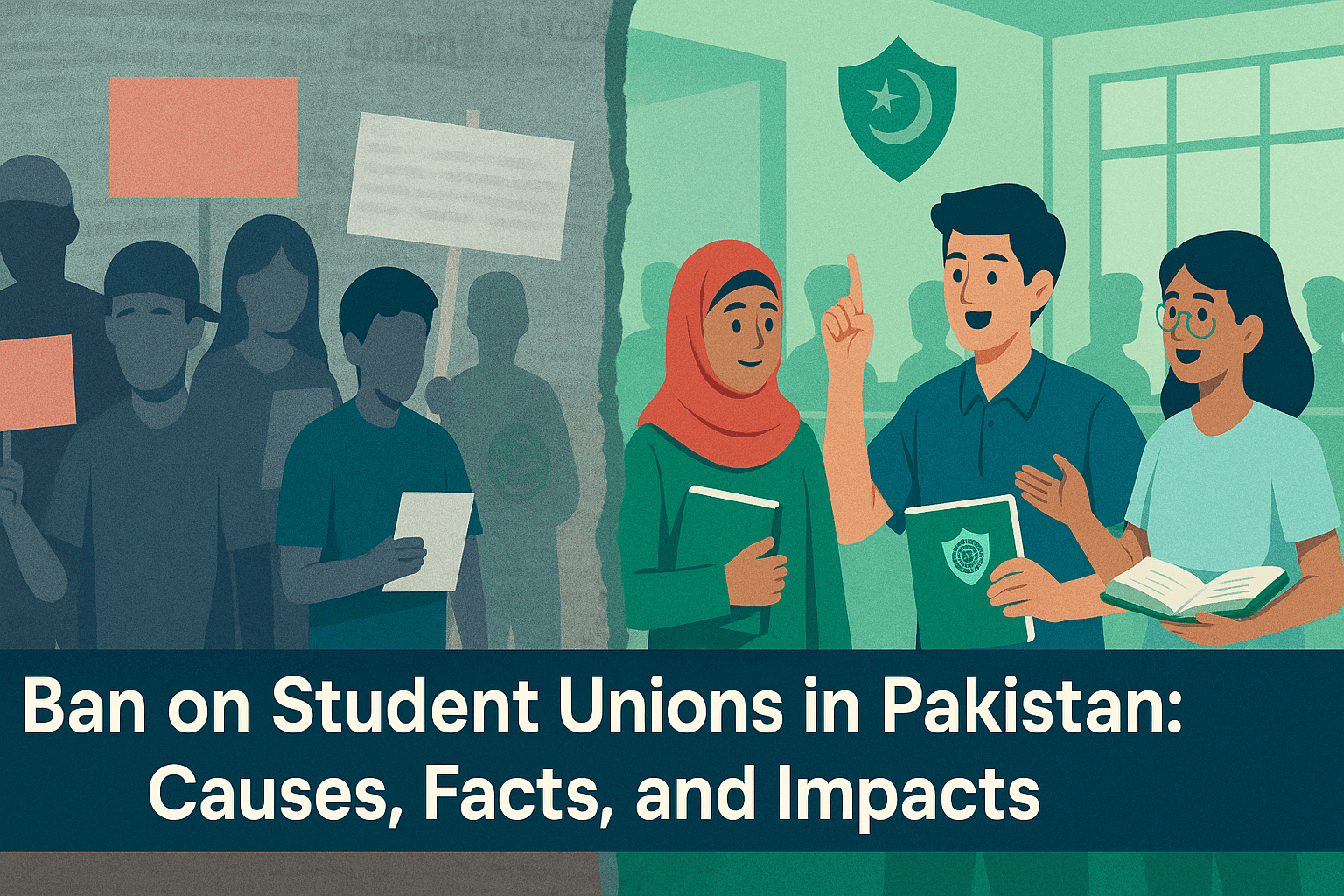
Ban on Student Unions in Pakistan: Causes, Facts, and Impacts
Introduction: Silencing the Voice of Students
The ban on student unions in Pakistan was introduced under the pretext of curbing violence on campuses. However, this justification has long been challenged. In reality, the decision aimed to silence collective student representation and weaken their political and democratic influence within educational institutions.
Research That Disproved the Official Narrative
A comprehensive research study conducted in 2004 examined the validity of these claims using official university records and media reports. The study compared two distinct eras:
-
The union-active period (1947–February 1984, approximately 36 years)
-
The post-ban period (February 1984–2004, approximately 20 years)
The findings completely dismantled the justification for the ban. Rather than reducing campus violence, the post-ban era saw a dramatic rise in disorder and lawlessness.
Key Findings:
-
During the 36 years of active unions, only 13 students lost their lives due to violence. In the 20 years after the ban, the number skyrocketed to 165.
-
Clashes increased from 151 incidents during the union era to 525 afterward.
-
Student expulsions rose from 110 during union activity to 985 following the ban.
These figures clearly indicate that the absence of student unions exacerbated violence rather than reducing it.
The Real Motive: Political Control and Suppression
The military dictator General Zia-ul-Haq enforced the ban not to maintain peace, but to consolidate his authoritarian power and curb the political strength of students. Historically, student unions in Pakistan played a decisive role in national movements — including the anti-Ayub Khan movement and the Tehreek-e-Khatm-e-Nabuwwat. Zia’s regime feared that such student-led mobilisations could challenge his rule, hence the decision to ban unions.
Democratic Failure and Political Fear
Subsequent democratic governments made little effort to restore the unions. Their reluctance stemmed from the fact that most political parties in Pakistan operate on dynastic leadership rather than democratic merit. The return of student unions would mean the rise of youth democracy in Pakistan — fostering leadership and political awareness that could undermine hereditary political control.
The Global Context and Islamic Student Movements
Another factor contributing to the ban was the increasing popularity of Islamic-oriented student organizations, particularly Islami Jamiat Talaba Pakistan (IJT). Their success in campus elections reflected a growing ideological shift that international powers viewed as concerning.
This perspective is echoed in Samuel P. Huntington’s renowned book, The Clash of Civilizations and the Remaking of World Order:
“In most countries, fundamentalists winning control of students’ unions and similar organizations was the first phase in the process of political Islamization... The Islamist appeal was particularly strong among students in technical institutions, engineering faculties, and scientific departments.” (Page 112)
This global outlook reveals how the political awakening of Islamic student movements, like IJT, was perceived as a threat to Western ideological dominance.
Consequences: Decline in Academic and Institutional Standards
The ban on student unions in Pakistan brought multiple negative consequences beyond politics. It led to deteriorating campus infrastructure, mismanagement, and rising issues like drug abuse, harassment, and violence.
For instance:
-
During the union period, the University of Karachi operated over 100 student buses; today, fewer than two dozen remain.
-
The majority of hostels at Punjab University, University of Peshawar, and Quaid-e-Azam University were constructed during the active union era, with minimal development since the ban.
These examples underscore how student representation and leadership once ensured effective advocacy for academic welfare and facilities — a dynamic missing today.
Loss of Representation and the Decline of Higher Education
Students are vital stakeholders in any academic ecosystem. Excluding them from decision-making and entrusting authority solely to administrative officials has worsened institutional inefficiency.
During the union era, student leaders actively lobbied for increased funding and infrastructure improvements. Today, bureaucratic administrations often fail to prioritise student welfare. As a result, Pakistan’s 266 universities struggle to compete internationally — with none ranked among the top 300 global universities.
Conclusion: The Need for Revival
In a nation where the youth form the majority, depriving them of their democratic platform is both unjust and detrimental to progress. The revival of student unions is essential for cultivating responsible leadership, restoring campus harmony, and strengthening democratic culture across Pakistan.
The time has come to recognise that empowering students through representation — not silencing them — is the true path to national development and unity.